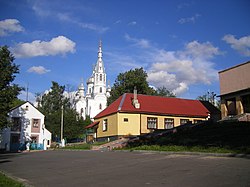Kamyenyets
Kamyanyets
Камяне́ц | |
|---|---|
 | |
| Country | |
| Voblast | Brest Voblast |
| Raion | Kamenets Raion |
| Mentioned | 1276 |
| Population (2002) | |
| • Total | 9,000 |
| Time zone | UTC+2 (EET) |
| • Summer (DST) | UTC+3 (EEST) |
| Postal code | 225050, 225051 |
| Area code | +375 1631 |
| License plate | 1 |
Kamyanyets (also spelled Kamenets) (Belarusian: Камяне́ц [kamʲaˈnʲets], Russian: Ка́менец, Polish: Kamieniec) is a town in the Brest Voblast of Belarus and the center of the Kamenets Raion. The town is located in the northwestern corner of Brest voblast on the Liasnaja river, about 40 km north of Brest. As of 2002, the population was about 9,000 people. Through Kamyanyets flows river Leśna Prawa.
History

It was first mentioned in the Halych-Volhynian Chronicle in 1276, when a castle with a keep, the tower of Kamyanyets, was being constructed on this spot, to protect the northern boundary of Volhynia from the raids of invaders. This site on the stony steep bank of the Liasnaja (Lysna or Leśna) River had attracted Oleksa, the prominent builder and architect of Volhynia. He showed the site to Vladimir Vasilkovich, the prince of Volhynia, who appreciated the place and ordered Oleksa to build a castle with a keep on the spot. Later a town appeared around the fortification. The tower is often called Bielaja Vieža (alternative transliteration: Belaya Vezha), which means White Tower or White Fortress in Belarusian, because after its foundation it was tiled in white. The neigboring relict forest of Belavezhskaya Pushcha received its name of White Tower. However, at our time the color of the castle is brick-red through the ages, not white.
The original name of the town comes from the Slavic word kamennyj what means stony in English, as it was founded atop a stony rise.
In 1366, it was incorporated into the Grand Duchy of Lithuania and in 1376 it was burnt by Teutonic Crusaders but rapidly rebuilt. In 1503, local townsfolk received a limited selfadministration right (probably the Maghdeburg right) that was used by 1795, when it was annexed by Russia. In 1588 and 1659, the town was devastated with plague.
Attractions
The main historical attraction is the tower that accommodates a museum.
External links
- Kamenets - Belarus at its BEST!
- Photos on Radzima.org
- Travel guide to Kamyanyets and Belavezhskaja Pushcha
- personal webpage
52°24′N 23°49′E / 52.400°N 23.817°E


